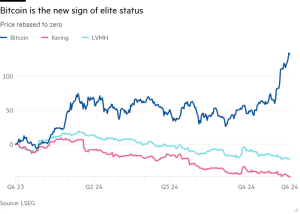Survivors of accidents on London bus and tubes accuse TfL of neglecting safety
Unlock the Editor’s Digest for free
Roula Khalaf, Editor of the FT, selects her favourite stories in this weekly newsletter.
Survivors of accidents on London’s bus and tube network and relatives of those who have been killed or injured have accused Transport for London of systemically neglecting safety.
One of those leading the campaign is Sarah de Lagarde, who, on her way home from work two years ago, slipped at High Barnet underground station and fell into the gap between the train and the platform. Commuters across London were horrified by her experience — she was run over by two trains before the alarm was called.
She is joined by Katrina Finnegan, whose 56-year old aunt Kathleen died in January this year after being hit by a double-decker bus at Victoria Station. Finnegan felt it was “a red flag” when she heard nothing from the bus company or TfL in the three weeks between her aunt’s death and burial. “We were sent no condolences or correspondence, although publicly they said they were helping the victim’s family.”
TfL said it had written to Katrina Finnegan to apologise for how it handled contact with her and Kathleen’s family following her death. “Following feedback from families, TfL has updated its processes around the way it communicates and contacts the families of those killed or otherwise involved in collisions on its network.”
This was not an isolated incident. Just one day after Kathleen died, four passengers were injured in Earl’s Court when a bus ploughed into a building. A few days before, a woman had been seriously injured in Lewisham after being hit by a bus, and two children were hit by a bus in Hackney. The previous month, a woman in her 70s had been killed by a bus at Walthamstow bus station.
Trish Burr’s daughter Melissa, 32, was killed at Victoria Bus Station in 2021 after a bus driver pressed the accelerator instead of the brake. Not only did Burr have to mourn her daughter, she also had to fight TfL’s claim that Melissa had been walking between two buses when she died. The suggestion that it was somehow Melissa’s fault, Trish Burr says, was incredibly hurtful. Last month TfL admitted that Melissa was actually on a pedestrian walkway when she was hit.
All three women — Sarah, Katrina and Trish — are furious about what they say is TfL’s defensiveness and victim-blaming. The initial report into Sarah’s fall said she was drunk — an allegation the Office of Rail and Road regulator later said was groundless. “I don’t want to have lost an arm and a leg for nothing” says Sarah, who has begun a civil claim against TfL. “This incident has left me with devastating injuries, yet TfL continues to deny any responsibility or address the serious safety concerns that have been raised.”
Nick Dent, director of customer operations at London Underground, said: “TfL is responding to a legal claim which has been brought by solicitors on behalf of Sarah De Lagarde and I am not in a position to comment publicly further.
“However, our thoughts continue to be with Sarah and her family following the devastating incident at High Barnet station. Safety is our top priority and we continue to take every possible measure to learn from any incident and put in place appropriate improvements.”
Twenty-one people a month on average have fallen between the train and the platform on London Underground between 2014 and 2023. This compares to between 80mn and 95mn passenger journeys in each four-week period during 2023.
In the last three months of 2023-24, 86 people died or were seriously injured in bus collisions. When compared with 12 other world cities including New York, Paris and Montreal, London’s buses have consistently been one of the worst performers for collisions. And the number of collisions has increased, post-pandemic, despite buses making fewer journeys. In 2022, the number of people killed or seriously injured as a result of collisions involving buses increased by 15 per cent compared with the 2017-2019 average.
Campaigners believe that driver exhaustion is a big factor. Research by Loughborough University and the Swedish National Road and Transport Institute in 2019 found 21 per cent of bus drivers fighting sleepiness on the job at least two to three times a week and 36 per cent reporting a “close call” due to fatigue in the previous 12 months. Six months ago, the London Assembly Transport Committee called for TfL and bus operators to take driver fatigue seriously.
TfL denies that drivers’ stress levels have been increased by iBus monitors, which show each driver where their bus is, relative to the one behind. Tom Kearney, an American businessman who was critically injured by a bus while standing on the pavement outside John Lewis on Oxford Street, disagrees. “DPD [the parcel company] removed its in-cab monitors after a pedestrian died, because it concluded the technology encouraged drivers to prioritise the timely delivery of parcels over human lives. The iBus display found in every TfL bus cab is almost exactly analogous to DPD’s.”
Questions have also been raised about London bus operators’ use of temporary staff, but the Mayor’s office said that TfL “does not routinely receive information” on how many accidents involve agency drivers.
“There is a history of TfL overlooking basic safety issues,” said Michael Liebreich, a former board member of TfL who has chaired its health and safety panel. “TfL knows that buses break the speed limit thousands of times per day, but it does nothing.”
Rosie Trew, TfL’s head of bus service delivery, said: “Safety is our utmost priority and we are committed to learning from every collision as part of our Vision Zero goal to eliminate death and serious injury on the network. This includes our comprehensive bus safety programme, which is driving major safety improvements across our network and funding specific interventions to reduce collisions.”
#Survivors #accidents #London #bus #tubes #accuse #TfL #neglecting #safety




